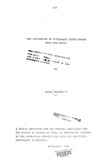| dc.description.abstract | This study set to estimate Nuptiality for Kenya using census data. The discussion is conducted at the levels, first at macro (national) level to examine the appropriateness of applying four alternative methods of refining estimates of Nuptiality. Second, at micro (regional) level to determine the regional patterns of Nuptiality. The interest stems from the relationship between Nuptiality and fertility. In societies in which control of marital fertility is absent or minimal, the pattern of age at first marriage (timing) and the proportions who ever marry (incidence) are the most important determinants of the overall fertility level. The prime aim of the study has been to facilitate understanding of the Nuptiality process in Kenya. By doing so, it is hoped that we may also gain further insight into its relationship with fertility. The main objective is to investigate the timing and incidence of Nuptiality using census data, at national and regional levels. To achieve this, the study is divided into six parts. The first is a general presentation of the problem. The second, presents the various methods for data evaluation and adjustment, as well as the estimation of Nuptiality. The third, is a detailed evaluation of the data quality and adjustments. The fourth, examines the Nuptiality situation at macro level, based on the 1969 and 1979 census data. The fifth, estimates regional Nuptiali ty levels, bibsing on SI1AM method alone, utilizing the 1979 census data for Kenya's 41 districts. The final, gives an overview of the findings, conclusions and recommendations beth for research and policy. Some methodological problems arise in the application of some of the methods to estimate Nuptiality from census data. Thus indiscriminate application of the methods should be cautioned against. The quality of data has greatly reduced the reliability of the derived estimates. Major conclusions drawn from the study are that Nuptiality timing is early for females and relatively late for males in Kenya. Most regions conform to these two patterns. The incidence of marriage is very high for both sexes. However, from this study it is not possible to make any definite assessment of the future course of marriage behaviour. It can, however be safely concluded that there is a growing trend towards single life or towards postponing legal marriage (especially on the part of females). This points to the observation that it is likely unions without a marriage certificate and the incidence of single parenthood will increase. Given Kenya's present fertility levels, policy measures should involve the increase in the timing and a decrease in the incidence of marriage. - | |

